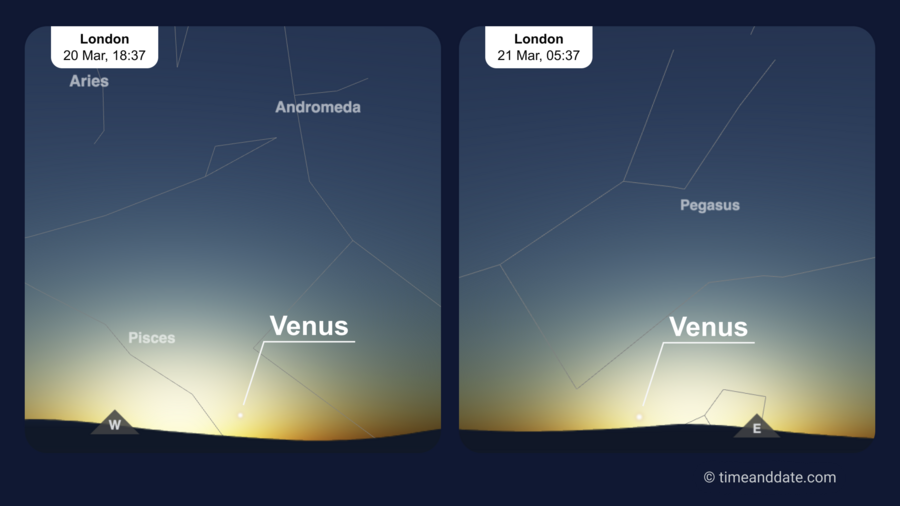
Why Does this Happen?
Well, this infrequent celestial event is only visible due to a quirk of Venus’s orbit around the Sun.
Since Venus orbits closer to the Sun than Earth, for nearly all locations it is visible either in the evening after sunset or in the morning before sunrise—but rarely both on the same night.
The duration of its visibility ranges from minutes to hours, depending on its position relative to the Sun, as seen from Earth.
However, this time, the Sun and Venus are unusually misaligned, creating a rare opportunity to see Venus as both a morning and evening star for a certain period, depending on your location.
Dr. Renate Mauland-Hus, our in-house astrophysicist, explains: “Venus’s orbital plane around the Sun is at an angle to the ecliptic—Earth’s orbital plane around the Sun. It is this geometry that allows for the misalignment to occur.”
Learn more about the eclipticA Double Appearance of Venus
Venus transitions from the evening to the morning sky around the time that the planet passes between Earth and the Sun. This process is known as its inferior conjunction.
Typically, around the time of Venus’s inferior conjunction, we lose sight of the planet for a short period of time since it becomes too close to the Sun’s bright glow in the sky.
During inferior conjunction, if Venus, the Sun, and the Earth were well aligned, we would witness a transit of Venus, where the planet appears as a small black dot passing in front of the Sun.
However, this time, Venus and the Sun are particularly misaligned, causing Venus to appear far enough north of the Sun to be visible in both the evening and morning skies from certain locations. This creates a rare “double appearance” window before the inferior conjunction, which happens on March 23 this year.
This phenomenon is relatively rare. Venus has a number of patterns that repeat every eight years, when Venus and Earth return to roughly the same point in their orbits. In fact, the last time that this double appearance of Venus happened was in 2017.
Find Venus on our Night Sky MapBest Viewing Times & Locations
This phenomenon can generally be seen from latitudes of London, UK, or further north. People in locations north of around 50° latitude, such as northern Europe and parts of Canada, have a chance to observe this event.
Interestingly, the further north you go, the more days this phenomenon will be visible. For example, in London, Venus will only be visible as a morning and evening star for one night on 20–21 March.
However, traveling further north to Oslo, Norway, the window is extended to 12–21 March. At an even higher latitude, from Fairbanks, Alaska, this event can be witnessed from 2–21 March.

Check our Night Sky Map to track Venus and find the best visibility and viewing times for your location.
If you’re one of the lucky ones to witness this rare phenomenon, be prepared for a fleeting sight! Depending on your location, Venus may only be visible for a very short window.
For example, our Night Sky Map shows us that, for London, Venus’s visibility is good from around 18:35 (6:35 pm) but only for a brief period of time. By 18:45 (6:45 pm), Venus will be dimming from view before disappearing entirely by 18:50 (6:50 pm).
To find Venus in the evening, look west not long after sunset, low down in the sky. If you’re an early bird, you’ll be able to spot Venus shortly before sunrise, close to the horizon in the eastern sky.
CAUTION: Be extremely careful when observing Venus in the morning.
DO NOT attempt to observe the planet when any part of the Sun is above the horizon. Because of Venus’s close proximity to the Sun, this could cause serious and irreversible damage to your eyes.
Tips for Observing Venus
In terms of preparation for this rare double appearance, the good news is that you won’t need any special equipment for viewing it, as Venus is the third brightest object in our sky after the Sun and the Moon.
Look for locations with unobstructed views of the horizons and remember to check the weather conditions for clear skies.
Perhaps set an alarm for the morning if you’re not a natural early riser! The opportunity to see Venus as the evening and morning star in one night won’t come around again any time soon.
A Star of Two Skies
Once Venus has passed onto the other side of the Sun, we will experience it as a morning star for roughly nine months before it transitions to an evening star again.
The entire cycle of Venus—from morning star to evening star and back again—takes about 584 days to complete. Astronomers refer to this as the synodic period of Venus.
Due to its shifting position in the sky, Venus was once thought to be two distinct stars—one appearing at dawn, the other at dusk. Many early astronomers were unaware that the morning and evening stars were actually the same object.
This fleeting phenomenon offers astronomy enthusiasts a special treat. Even though it lasts only a short time, it’s a spectacle worth witnessing.
